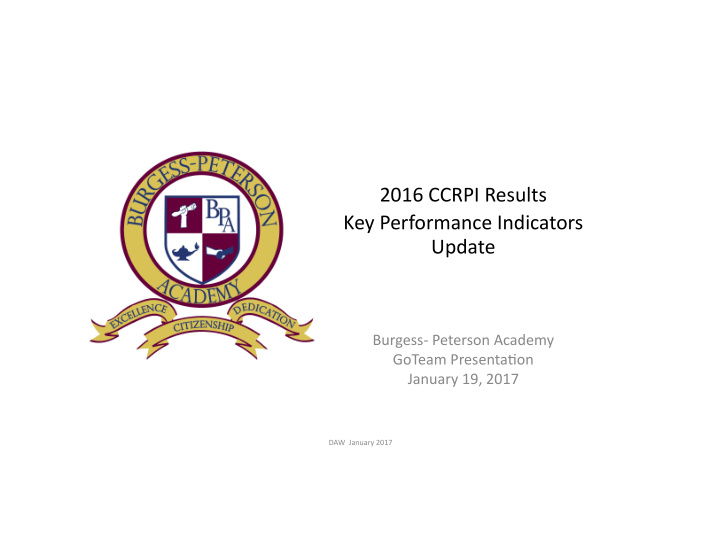



2016 CCRPI Results Key Performance Indicators Update Burgess- Peterson Academy GoTeam PresentaFon January 19, 2017 DAW January 2017
BPA CCRPI Over Time 2012 2013 2014 2015 2016 52.8 85.2 78.4 74.3 80.5 Less than 60 Failing School 60-69 “D” 70-79 “C” 80-89 “B” 90-100 “A” DAW January 2017
APS / Georgia / BPA Comparison 2016 CCRPI BPA APS Georgia 80.5 65.6 71.7 • BPA Outscored the District by 14.9 points. • BPA Outscored the State by 8.8 points. DAW January 2017
DAW January 2017
+4.4 -2.4 -0.8 +5.0 DAW January 2017
Achievement- worth 50 points BPA got 29 Sub-components # of Component Examples Elements Content Mastery 4 GMAS • Weighted % scoring at or above the End of Developing Learner level Grade • Developing (.5) • Proficient (1) (EOG) • DisFnguished (1.5) Post Elementary 6 Elem. • % of SWD served in general educaFon School Readiness classes more that 80% of the day • % of 3 rd grade students scoring at or above a lexile of 650 • % of students missing fewer than 6 days Predictor for High 1 Elem. • % of students scoring at the Proficient of School GraduaFon DisFnguished Learner level DAW January 2017
Progress- worth 40pts & Achievement Gap- worth 10pts BPA got 37 BPA got 7.5 Components # of Wt./ Component Examples Elements Pts. Progress 4 40% • 4 core subject areas for ES & MS • 8 course exams (high schools) Achievement Gap 4 10% • Gap Size and Gap Progress • Progress Points – measures the academic growth achieved from year to year. Schools earn points for percentage of students whose academic performance on state tests is considered typical or high compared to other Georgia students with similar test scores from the prior year. • Achievement Gap Points – schools earn points based on (a) the average performance of the lowest 25 percent of students compared to the average performance of Georgia students statewide; and (b) the change in the achievement gap between years. DAW January 2017
Challenge Points- worth 10pts BPA got 7pts Sub-components # of Component Examples Elements ED/EL/SWD • 12 • Elementary and Middle schools – 12 performance flags (for four EOG tests) Performance Flags Exceeding the Bar • 7 (ES) • % of 5 th graders compleFng career Indicators (.5 points porholios each) • % of teachers using Statewide Longitudinal data System (SLDS) • % of students earning a passing score in a fine arts or world language course • Maximum points is 10. Total number of ED/EL/SWD Performance points possible is dependent on the size of that populaFon. • Most APS schools currently earn 1-2 Challenge points. DAW January 2017
Schools with Highest CCRPI Scores School Grade Band Cluster CCRPI Lin E Grady 98.9 Carver Early College* H Carver 97.3 Brandon E North Atlanta 97.0 Morningside E Grady 96.5 Springdale E Grady 95.6 Jackson Elementary E North Atlanta 95.4 Inman Middle M Grady 91.6 ANCS Elementary E Charter 84.5 Drew Elementary E Charter 83.8 Smith E North Atlanta 83.8 West Manor* E Mays 82.1 Garden Hills* E North Atlanta 82.0 Cleveland* E South Atlanta 80.8 Burgess-Peterson* E Jackson 80.5 • The highest performing schools include several Title I schools –Carver Early College, Drew Elementary, West Manor, Garden Hills, Cleveland, and Burgess. DAW January 2017
Schools with Highest CCRPI Gains School Grade Band Cluster CCRPI Gains Carver Tech H Carver 13.5 Whitefoord E Jackson 13.1 Perkerson E Carver 9.5 Classical E/M Charter 9.3 Dunbar E Jackson 9.2 Cleveland E South Atlanta 8.6 Miles E Mays 7.2 Burgess-Peterson E Jackson 6.2 Lin E Grady 5.7 VeneFan Hills E Washington 5.7 Jackson High H Jackson 5.2 Centennial E/M Charter 5.1 • Thirty-three schools achieved gains in their CCRPI score. • Twelve schools achieved gains of more than 5 points. DAW January 2017
Schools with Highest Progress Points School Grade Band Cluster Points Cleveland* E South Atlanta 40.0 39.5 Inman M Grady Lin E Grady 39.5 KIPP WAYS* E/M Charter 38.5 Brandon E North Atlanta 38.0 Parkside* E Jackson 38.0 Garden Hills* E North Atlanta 37.7 Burgess* E Jackson 37.0 • The maximum amount Progress Points a school can earn is 40. • Schools earn points for the percentage of students whose academic growth on the state tests is considered typical or high compared to other Georgia students with similar test scores. DAW January 2017
Recommend
More recommend